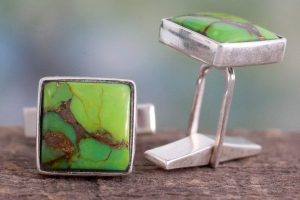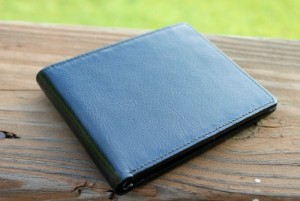Handcrafted Leather Wallets And Tooled With Designs
Men's Accessories(804 items)
![]()
![]() What materials are used to make men's rings?
What materials are used to make men's rings?
Global artisans use all sorts of materials in their handcrafted jewelry for men. In the Andes, sterling silver, leather, and combinations of natural stones are frequently used. In Bali, silver, gold, bone, wood, brass, and stainless copper adorn handmade jewelry. In West Africa, men's jewelry honors the cow, where bone and horns are incorporated into unique pieces.
![]()
![]() What are the most popular materials to make mens bracelets?
What are the most popular materials to make mens bracelets?
Traditional artisans handcraft jewelry using the techniques and materials of their ancestors. In Indonesia, the most common mens bracelet is made from Akar Baharnatural, or black, coral. In the Andes, sterling silver, leather, waxed cotton threads, or natural stones adorn handmade jewelry. In Central America, the list includes: gold, brass, cord, wood, or glass. West Africa also makes use of these materials, plus wooden beads. And India incorporates gemstones into its rich history of jewelry.
![]()
![]() How do I know if my bracelet is handmade?
How do I know if my bracelet is handmade?
Excellent question! There is no simple test that can tell you whether an artisan hand-crafted your jewelry or not. No easy way to know if an item is handmade or factory-produced. But there are details that you can look out for, and hopefully a discerning eye will guide you right. First, look at materials. If a bracelet is made of leather with embossed detailing, or sterling silver with intricate carvings or stone settings, you are entering the realm of the handmade. If a bracelet is made from bone, or makes use of complicated beadwork, if there is evidence of welding or carving, then you can feel good about your purchase. Any true artisan will tell you: no two pieces of jewelry will come out identical if they are made by hand. Beware of sameness. Celebrate the idiosyncrasies of the artists hand and help preserve the techniques and traditions of the past.
![]()
![]() Do any men's bracelets have particular cultural significance?
Do any men's bracelets have particular cultural significance?
Since time immemorial, jewelry has been used as a personal ornament, religious signification, or tastes in fashion. Today's handcrafted artisan jewelry is no different. In West Africa, leather is prized by certain tribes and connotes a connection to culture. In Indonesia, black coral, or Akar Bahar, is believed to protect the wearer from witchcraft and evil, and so it is used in many jewelry items for men. In Peru, leaders adorned themselves with garments that were exclusive to their rank, so men's jewelry not only indicated their function, but was also steeped in iconography, religious code, and emblems of power and prestige. In India, artisan jewelry incorporates the motifs of Om, a spiritual symbol signifying the essence of consciousness, and Lord Ganesha, the god of beginnings who is honored at the start of rites and ceremonies. Today, artisans working in these classical styles preserve the heritage that was passed down to them over time.
![]()
![]() What are the meanings behind some of the popular stones used for mens rings?
What are the meanings behind some of the popular stones used for mens rings?
To understand the significance of traditional, handcrafted men's rings, we need to talk about stones. All over the world, stones reveal deep cultural connections to the land, belief systems, and aspirations. In Peru, artisan jewelry makes use of chrysocolla (also known as "Peruvian turquoise"), which was used by the Incas as an inlay in their goldwork. They believed it calmed their emotions and strengthened their immune defenses because it had medicinal powers. In Bali, kecubung (Amethyst) is incorporated into handmade rings because it brings peace to those who wear it. Kalimaya (Opal) is believed to stabilize the mental well-being of the wearer. In Guatemala, jade is the stone of choice, as the Mayans attributed special powers to it, believing it symbolized life, fertility, and power. In India, onyx is a stone of vigor and stamina, which strengthens self-confidence, banishes grief, and stimulates wise decision-making. Lapis lazuli relieves anger and negative thoughts and eases frustrations. Tigers eye stone aids harmony and balance and helps release fear and anxiety. The list of unique stones is as long as the master craftspeople who use them in their traditional jewelry.
![]()
![]() What have men's rings represented throughout history?
What have men's rings represented throughout history?
From wedding rings to religious symbols, men's rings have carried tremendous significance throughout history. In West Africa, rings were originally used to represent God's unmatched power and the authority of mankind on earth. In India, handcrafted rings have been used to symbolize everything from devotion and fidelity to eternity and belief in a deity. Today, like in many cultures, Indian rings represent love, engagement and marriage. Pre-Hispanic cultures in Central America and South America used handmade jewelry to denote social position, rank, as well as personal adornment. Metal, bone, shell, and stoneparticularly jadewere chosen for beauty and durability. Even the choice of metal has meaning in particular cultures. The Incas, for example, believed that gold was a sacred metal sent by the sun god, Inti, and all mines belonged to the emperor, who protected his metals with great zeal.
![]()
![]() What mens ring motifs have special cultural significance?
What mens ring motifs have special cultural significance?
Men have worn rings since ancient times as a personal ornament, a sign of social position, official rank, or a symbol of religious beliefs. Handmade jewelry may reflect changes in fashion, but it remains rooted in the history and culture of a people and place. Each unique ring reveals the artistic sensibility of its maker, yet certain symbols and motifs appear frequently. In India, the Om motif has special cultural significance as a sacred spiritual symbol. It signifies ultimate reality, or consciousness. In Bali, the Om Kara, or Ongkara, represents five elements: wind, fire, ether, water, air, and earth, which correspond to different aspects of the human body. Religion and mythology are also manifest in traditional jewelry. Lord Ganesha, one of the most worshipped deities in the Hindu pantheon, is revered as the remover of obstacles, the patron of arts and sciences, and the god of intellect and wisdom. In Bali, Barong is a lion-like mythical creature that symbolizes victory and spiritual protection. These symbols and others can be found on handmade rings from around the world and are ways of honoring history, culture, and spirituality.
![]()
![]() How do I care for my shawl?
How do I care for my shawl?
Hand-washing and dry cleaning are the most common ways to care for and clean shawls. Many of our alpaca shawls specifically indicate dry-cleaning or hand-washing with cold water. Because shawls are delicate, a garment bag is a good way to prevent damage. Avoid direct sunlight and high heat. As always, it is important to follow the care instructions specific to the fabric of your shawl.
![]()
![]() How warm are shawls?
How warm are shawls?
The great thing about shawls is that they are versatile. One can find a shawl for every season. Warmth is often based on the tightness of the weave and the type of material used. Alpaca fiber is known for its thermal capacity and provides an optimal degree of warmth. Sheep wool also acts as an insulator, absorbing moisture and creating a feeling of coziness for the wearer. Shawls made of cashmere and pashmina are light and thin, yet still provide a high degree of warmth. In Mexico, shawls made from San Juan Chamula sheep keep one warm and comfortable.
![]()
![]() What shawls are most comfortable?
What shawls are most comfortable?
Comfort is always a question of preference, but certain fabrics lend themselves to softness and warmth. Shawls from the Andes are made from super soft alpaca fibers, and provide wearers a high level of comfort. Similarly, in Thailand and Bali, silk shawls are always favorites. Depending on ones climate, particular shawls may be preferable. Central American shawls made from cotton and rayon keep wearers cool in warm climates, whereas bamboo and acrylic shawls are great for cold weather. During hot summers, Indian shawls made of modal, silk, and viscose are a perfect option, and merino wool and cashmere are ideal for winter. West Africa stands by the luxurious comfort of their 100% cotton shawls, and Mexico prioritizes comfort with their beautiful wool designs.
![]()
![]() Are your shawls handmade?
Are your shawls handmade?
It depends on what you mean by handmade. We support artisans who work in the ancient traditions of their ancestors, crafting items by hand, with patience and love. But techniques vary among shawl makers. Embroidery, hand-painting, stitching, and sewing are often part of the process. Some artisans do use power looms when crafting their shawls, but even in those instances, there is no mega-factory or mass production line behind the garment. The beauty, creativity, and inspiration for each shawl comes from the artists own heart. Our product descriptions will always specify if an item is hand-woven, hand-knit, or otherwise.
![]()
![]() Are there any common motifs or designs used in traditional shawls?
Are there any common motifs or designs used in traditional shawls?
The shawl comes to us full of history, culture, and heritage. Each region invests its shawls with different symbols, patterns, and designs. Some shawls, like those in West Africa and the Andes, feature linear and geometric shapes, clean lines and patterns that have been passed down through the centuries. In Bali, we find elaborate batik designs, a technique that makes use of alternating dye and wax to block color. In Central America, embroidered and woven shawls incorporate designs inspired by corn, butterflies, and birds. Floral patterns are very popular in Indian shawls, particularly in pashminas from Kashmir. Gujarati shawls often depict geometric shapes, and artisans increasingly incorporate contemporary designs through hand-painted fabric. Thailand also integrates floral patterning, often using the yok dok technique, a brocade style that leaves the fabric slightly raised. This emphasis on brocade is also evident in Mexican shawls, with lavish designs in the form of frets, flowers and geometric figures, all inspired by pre-Hispanic cultures.
![]()
![]() What materials are used to make shawls?
What materials are used to make shawls?
Fibers, dyes, and fabrics come together in innovative, unique ways during the creation of a shawl. Different regions rely on resources that are readily available and have cultural significance. In West Africa, 100% cotton and rayon frequently make their appearances in shawls. In Bali and Thailand, soft silk lends a luxuriousness to the shawl. Central American artisans incorporate bamboo rayon, while India makes use of wool and silk. Mexico boasts an array of vibrant natural and cotton yarn dyes, and artisans from the Andes weave shawls out of soft alpaca fiber.
![]()
![]() What are the most popular methods for making traditional shawls?
What are the most popular methods for making traditional shawls?
Throughout the world, the shawl is considered a venerated garment, made by hand from techniques passed down through generations. The methods for making traditional shawls vary as widely as the regions from which they come. But most employ some method of hand knitting or weaving on a loom. In the Andes, for example, crocheting and flat weaving on a treadle loom are common techniques. In Central America, backstrap and foot looms are popular with artisans. In Bali, one finds intricate sewing, in addition to weaving. And in India and Thailand, practices of hand-painting fabric, batik, and the use of natural dyes are intimately tied to the creation of shawls.
![]()
![]() Were men's bracelets worn throughout history?
Were men's bracelets worn throughout history?
More than a mere fashion statement, men's jewelry, including bracelets, have been worn throughout history to communicate cultural, religious, and social beliefs. Prehistoric man adorned his wrists with bones and shells to ward off evil spirits. Wealthy men wore bracelets made of gold and silver to display their power and status. Bracelets evolved over time from good luck charms to status symbols to modern style accessories. All the while, they pick up and preserve meaning from the past. In Peru, gold and silver bracelets were meant to complement each other symbolically. Gold represented the sun, the day, and the masculine. Silver represented the moon, the night, and the feminine. These two bright, powerful metals held one another in balance. In Central America, natural materials decorated men's jewelry to signify a connection to place. Metals, bone, shells, bird feathers (especially the beautiful quetzal bird), and carved stones (particularly jade for its power of fertility and life) protected and decorated the wearer.
![]()
![]() What makes a necklace eco-friendly?
What makes a necklace eco-friendly?
Many traditional artisans employ the handcrafted techniques of their ancestors, which favored a slow, methodical approach in a small workshop, as opposed to mass production. Today, they preserve these methodologies while intentionally distinguishing their approaches from those of large factories. Respect for the environment, and for animal and human life drive the artwork itself. Natural materials are often a sign that a product is eco-friendly. Additionally, many artisans look for ways to reuse or recycle in their artwork. Some choose to repurpose old wood or fabric. Some recycle glass beads or up-cycle plastic and discarded paper. Others follow practices that conserve resources, like water and energy, and are mindful of the pollutants they release into the environment. Shopping from organizations that promote eco-friendly products is the best way to ensure that you are receiving a unique item that does not damage the world through its making.
![]()
![]() Are there specific cultural symbols used in mens necklaces?
Are there specific cultural symbols used in mens necklaces?
Handcrafted mens jewelry captures our undying passion for symbols and meaning through a variety of designs, emblems, and carvings. In ancient Peru, men wore necklaces adorned with pendants of human, animal, and divine characters. A common symbol that has withstood the test of time is the Andean Chakana, or the staggered cross, that attests to the relationship between humankind and the cosmos. In Bali, mens jewelry integrated the cross, the sign of freedom, and Ongkara symbol for oneness and spirituality. In Central America, carved glyphs were commonly used. Animal figures and bird feathers (like the quetzal and macaw) had special significance, as did natural stones. In India, Om and Ganesha symbols are used for protection, prosperity and purity. In West Africa, Gye nyame, symbolizing Gods deep power and infinite knowledge, is still used on necklaces.
![]()
![]() On which finger or hand should mens rings be worn?
On which finger or hand should mens rings be worn?
There is no right way to wear mens rings. Right hand, left hand, ring finger or thumb, where you place your ring is as much a matter of preference and comfort as it is style. Besides the common ring finger to signify love or marriage, other fingers of note are the index finger, which symbolizes power, leadership, and authority in some cultures, and the thumb, which can signify wealth. Wherever you choose to don it, a handmade ring should be as unique as the man who wears it.
![]()
![]() What are the signs of a well-made necklace?
What are the signs of a well-made necklace?
Like many things, when it comes to great craftsmanship, the evidence is in the details. We asked artisans what they look for in a good necklace, and heres what they told us. Keep your eye out for the smooth functioning of the lock. It should clasp easily and cleanly. Examine the weldings of the chain joints, and pay attention to the surface of the jewelry. Is it finished in high polish? Are handcrafted details evident? Are engravings handmade? Artisans also look for uniqueness in design, integrity of workmanship, and high-quality materials. Necklaces should be free from dents, and beads should stay fastened in place. No chips in the gemstones, no cuts in the bezel, and no obvious glue marks of any kind. While these standards may seem high, we believe that artisan jewelry should aim for the stars.
![]()
![]() What are the most common materials for making mens necklaces?
What are the most common materials for making mens necklaces?
The materials that comprise handmade artisan necklaces are as varied as the makers themselves. Craftspeople all over the world use metals, like sterling silver, gold, copper and brass, to perfect their designs. Cotton or nylon cord and leather are also common materials used in traditional mens jewelry. Wooden beads, cow bones, coconut shells, bamboo, and gemstones all adorn mens necklaces from across the globe.
![]()
![]() How should men's bracelets be styled?
How should men's bracelets be styled?
Unique, stylish, and handcrafted. These are the guiding principles of wearing men's jewelry with confidence. There are no rules when it comes to men's bracelets. You can wear simple leather, or a combination of metals. You can go understated or bold. Colorful or subdued. However you choose to display your handmade jewelry, what matters most is that you discover pieces that attest to your own originality.
![]()
![]() What men's bracelet-making techniques have been passed down through generations?
What men's bracelet-making techniques have been passed down through generations?
Techniques that rely on handmade craftsmanship honor the cultures and regions from which they come. In Bali, repouss, or the art of silver filigree, is still preserved by artisans today. In Central America, jewelry-makers work with natural stones, especially jade, in order to celebrate the techniques and materials used by their ancestors. In India, sterling silver jewelry is made through intricate jali carving or rawa (silver beading). Hand-casting and gemstone-cutting have also been passed down through the generations, and today, make their way into unique works of wearable art. In West Africa, fabrication (including soldering or welding) is a technique that has stood the test of time, as has leather twisting, which adorns mens jewelry from bracelets to necklaces.
![]()
![]() What are traditional techniques for designing men's rings?
What are traditional techniques for designing men's rings?
The traditional techniques used to create artisan jewelry are as diverse as the cultures from which they come. In Peru, the ancient technique of handmade goldsmithing continues in the work of filigree, the art of weaving silver threads together. Originally brought to the Andes during the colonial period, filigree acquired local nuances and incorporated designs inspired by nature and daily life. In Bali, handmade jewelry makes use of a method called repouss, a decorative, detail-oriented artform that uses hammers and punches to raise metal in relief from the background of the ring. In West Africa, fabrication, casting, and forging are common handcrafted techniques, whereas in India, it is common to see cut gemstones intricately fitted within silver segments.

Silver Cufflinks – A Fitting Gift for the Dapper Man
In my mind, cufflinks are the accessories that take a nice-looking suit to the next level. They can transport... read more

Thinking Ahead to Father's Day Gifting
Fathers day is fast approaching, giving us the perfect opportunity to celebrate that special father in our... read more

Can't Miss Father's Day Gifts From NOVICA
Because they are given with love, theres no such thing as a bad Fathers Day gift. But, lets face it, those... read more

Simple Style for the Gents: Handmade Leather Wallets
.single.postid-4244 .entry-media { display: none; } Of the 23 people on my list of people I buy gifts for... read more

A Man's Take on Valentine's Day Gifts for Men
A brief history of Valentines Day: It began as the pagan festival known as Lupercalia, a fertility celebration... read more
Handcrafted Leather Wallets And Tooled With Designs
Source: https://www.novica.com/accessories/mens/
Posted by: haleycouldic1973.blogspot.com

0 Response to "Handcrafted Leather Wallets And Tooled With Designs"
Post a Comment